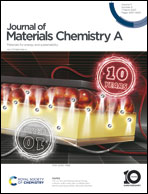Through-hole graphite made from waste graphite for high-rate lithium-ion battery anodes†
Abstract
The cost of high-performance artificial graphite has been increasing in recent years, while low-cost natural graphite has also been listed as a supply-risk material. Therefore, finding a new supply chain to alleviate the above problems is urgent. Herein, we designed a simple combined process involving high-temperature oxidation and magnetic separation, where the optimum temperature was 480 °C. The waste graphite (DSG) from diamond production was converted into a through-hole graphite material (denoted as MDSG-480). MDSG-480 exhibited superior rate performance and long-cycle stability compared with natural flaky graphite (NFG). In particular, the reversible capacity could reach 125 mA h g−1 after 1200 cycles at 5C, which is seven times more than that of natural flaky graphite (NFG). The outstanding performance of MDSG-480 was attributed to the through-hole, which served as a container for the electrolyte on the graphite surface and shortened the distance between the lithium ion and graphite layer as well as the diffusion path within the electrode. Moreover, this study proves that through-hole graphite can reduce the initial potential of the electrode under high current density and the feasibility of manufacturing high-performance graphite anode with DSG.

- This article is part of the themed collection: #MyFirstJMCA


 Please wait while we load your content...
Please wait while we load your content...